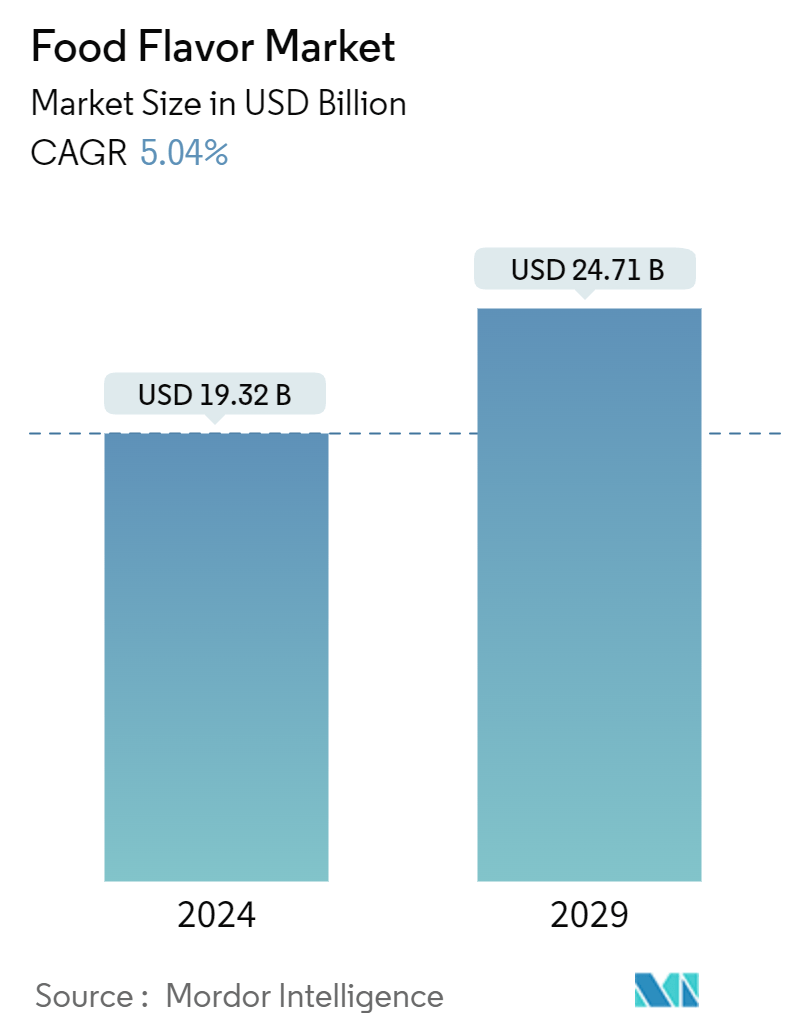Market Size of Food Flavor Industry

| Study Period | 2019 - 2029 |
| Market Size (2024) | USD 19.32 Billion |
| Market Size (2029) | USD 24.71 Billion |
| CAGR (2024 - 2029) | 5.04 % |
| Fastest Growing Market | Asia |
| Largest Market | Asia |
| Market Concentration | Medium |
Major Players.webp)
*Disclaimer: Major Players sorted in no particular order |
Food Flavors Market Analysis
The Food Flavor Market size is estimated at USD 19.32 billion in 2024, and is expected to reach USD 24.71 billion by 2029, at a CAGR of 5.04% during the forecast period (2024-2029).
Various factors, including shifting consumer preferences, evolving industry trends, and global influences, are driving the demand for food flavors worldwide. As consumers increasingly seek out nutritionally enriched and all-natural products, the market is witnessing a surge in demand for premium, natural additives and flavors. This trend is further bolstered by the growing popularity of botanical flavors, especially for their perceived health benefits among consumers. Consumers prefer products that go beyond basic nutrition, focusing on elements like probiotics, ginger, and trendy adaptogens like moringa, turmeric, and coffee bean extract. These ingredients are aimed at bolstering the immune and digestive systems and providing an energy boost in functional foods and beverages. Furthermore, consumers are turning to herbal and botanical extracts, like lavender, roses, chamomile, cinnamon, and cardamom, to meet goals related to mood enhancement, beauty, and antioxidant intake. In addition, advances in food technology have enabled the creation of more complex and nuanced flavors. Techniques such as fermentation, molecular gastronomy, and flavor encapsulation allow for developing new and innovative taste profiles.
Food Flavors Industry Segmentation
Food flavors are ingredients used to improve the flavor of food and beverage products.
The global food flavor market is segmented by type, application, and geography. By type, the market is segmented into natural flavor, synthetic flavor, and nature-identical flavoring. By application, the market has been segmented into dairy, meat, bakery, confectionery, savory snack, beverage, and other applications. By geography, the market is segmented into North America, Europe, Asia-Pacific, South America, the Middle East, and Africa.
The report offers market size and forecasts for the confectionery market in value (USD) for all the above segments.
| Type | |
| Natural Flavor | |
| Synthetic Flavor | |
| Nature Identical Flavoring |
| Application | |
| Dairy | |
| Bakery | |
| Confectionery | |
| Savory Snack | |
| Beverage | |
| Meat | |
| Other Applications |
| Geography | |||||||||
| |||||||||
| |||||||||
| |||||||||
| |||||||||
|
Food Flavor Market Size Summary
The food flavors market is experiencing significant growth, driven by the increasing demand for ready-to-eat foods, beverages, snacks, and other processed foods. This trend is fueled by urbanization, a rising middle class, and increased disposable income in both developed and developing regions. As a result, there is a growing need for food additives to maintain the freshness and taste of these products. The market is also witnessing a surge in the popularity of compounded and exotic flavors, as consumers seek new and unique taste experiences. However, there is a notable shift towards natural flavors due to growing health concerns over artificial ingredients. Consumers are increasingly favoring plant-based and clean-label products, prompting manufacturers to focus on natural and organic flavor options.
The global food flavor market is highly competitive, with key players like Kerry Group, Givaudan, Cargill Inc., Archer Daniels Midland Company, and Symrise AG leading the charge. These companies are adopting strategies such as introducing clean labels, expanding organic flavor ranges, and forming partnerships to enhance market penetration. The demand for natural flavors is particularly strong in regions like the United Kingdom, France, and Germany, where there is a high consumption of organic and dairy products. Additionally, regulatory changes and consumer awareness in countries like Russia are driving the demand for clean-label products. The market is expected to continue its growth trajectory as companies invest in natural ingredients and expand their geographic reach through online distribution channels and strategic acquisitions.
Food Flavor Market Size - Table of Contents
-
1. MARKET DYNAMICS
-
1.1 Market Drivers
-
1.1.1 Increasing Preference for Ready Meals
-
1.1.2 Launch of Natural Variants
-
-
1.2 Market Restraints
-
1.2.1 Changing Regulatory Landscape
-
-
1.3 Porter's Five Forces Analysis
-
1.3.1 Bargaining Power of Buyers/Consumers
-
1.3.2 Bargaining Power of Suppliers
-
1.3.3 Threat of New Entrants
-
1.3.4 Threat of Substitute Products
-
1.3.5 Intensity of Competitive Rivalry
-
-
-
2. MARKET SEGMENTATION
-
2.1 Type
-
2.1.1 Natural Flavor
-
2.1.2 Synthetic Flavor
-
2.1.3 Nature Identical Flavoring
-
-
2.2 Application
-
2.2.1 Dairy
-
2.2.2 Bakery
-
2.2.3 Confectionery
-
2.2.4 Savory Snack
-
2.2.5 Beverage
-
2.2.6 Meat
-
2.2.7 Other Applications
-
-
2.3 Geography
-
2.3.1 North America
-
2.3.1.1 United States
-
2.3.1.2 Canada
-
2.3.1.3 Mexico
-
2.3.1.4 Rest of North America
-
-
2.3.2 Europe
-
2.3.2.1 Spain
-
2.3.2.2 United Kingdom
-
2.3.2.3 Germany
-
2.3.2.4 France
-
2.3.2.5 Italy
-
2.3.2.6 Russia
-
2.3.2.7 Rest of Europe
-
-
2.3.3 Asia-Pacific
-
2.3.3.1 China
-
2.3.3.2 Japan
-
2.3.3.3 India
-
2.3.3.4 Australia
-
2.3.3.5 Rest of Asia-Pacific
-
-
2.3.4 South America
-
2.3.4.1 Brazil
-
2.3.4.2 Argentina
-
2.3.4.3 Rest of South America
-
-
2.3.5 Middle-East and Africa
-
2.3.5.1 South Africa
-
2.3.5.2 Saudi Arabia
-
2.3.5.3 Rest of Middle-East and Africa
-
-
-
Food Flavor Market Size FAQs
How big is the Food Flavor Market?
The Food Flavor Market size is expected to reach USD 19.32 billion in 2024 and grow at a CAGR of 5.04% to reach USD 24.71 billion by 2029.
What is the current Food Flavor Market size?
In 2024, the Food Flavor Market size is expected to reach USD 19.32 billion.

